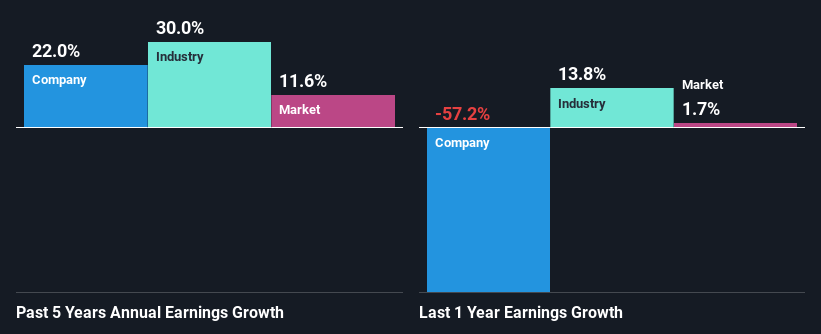Should Weakness in CML Microsystems plc's (LON:CML) Stock Be Seen As A Sign That Market Will Correct The Share Price Given Decent Financials?
CML Microsystems (LON:CML) has had a rough month with its share price down 16%. However, the company's fundamentals look pretty decent, and long-term financials are usually aligned with future market price movements. Specifically, we decided to study CML Microsystems' ROE in this article.
Return on equity or ROE is a key measure used to assess how efficiently a company's management is utilizing the company's capital. In short, ROE shows the profit each dollar generates with respect to its shareholder investments.
Check out our latest analysis for CML Microsystems
How To Calculate Return On Equity?
ROE can be calculated by using the formula:
Return on Equity = Net Profit (from continuing operations) ÷ Shareholders' Equity
So, based on the above formula, the ROE for CML Microsystems is:
4.0% = UK£2.1m ÷ UK£51m (Based on the trailing twelve months to March 2024).
The 'return' is the profit over the last twelve months. So, this means that for every £1 of its shareholder's investments, the company generates a profit of £0.04.
What Has ROE Got To Do With Earnings Growth?
So far, we've learned that ROE is a measure of a company's profitability. Based on how much of its profits the company chooses to reinvest or "retain", we are then able to evaluate a company's future ability to generate profits. Assuming everything else remains unchanged, the higher the ROE and profit retention, the higher the growth rate of a company compared to companies that don't necessarily bear these characteristics.
CML Microsystems' Earnings Growth And 4.0% ROE
On the face of it, CML Microsystems' ROE is not much to talk about. A quick further study shows that the company's ROE doesn't compare favorably to the industry average of 15% either. Despite this, surprisingly, CML Microsystems saw an exceptional 22% net income growth over the past five years. We reckon that there could be other factors at play here. Such as - high earnings retention or an efficient management in place.
As a next step, we compared CML Microsystems' net income growth with the industry and were disappointed to see that the company's growth is lower than the industry average growth of 30% in the same period.
Earnings growth is a huge factor in stock valuation. It’s important for an investor to know whether the market has priced in the company's expected earnings growth (or decline). By doing so, they will have an idea if the stock is headed into clear blue waters or if swampy waters await. If you're wondering about CML Microsystems''s valuation, check out this gauge of its price-to-earnings ratio, as compared to its industry.
Is CML Microsystems Using Its Retained Earnings Effectively?
CML Microsystems' three-year median payout ratio is a pretty moderate 42%, meaning the company retains 58% of its income. This suggests that its dividend is well covered, and given the high growth we discussed above, it looks like CML Microsystems is reinvesting its earnings efficiently.
Moreover, CML Microsystems is determined to keep sharing its profits with shareholders which we infer from its long history of paying a dividend for at least ten years.
Conclusion
On the whole, we do feel that CML Microsystems has some positive attributes. Namely, its respectable earnings growth, which it achieved due to it retaining most of its profits. However, given the low ROE, investors may not be benefitting from all that reinvestment after all. While we won't completely dismiss the company, what we would do, is try to ascertain how risky the business is to make a more informed decision around the company. Our risks dashboard would have the 6 risks we have identified for CML Microsystems.
Have feedback on this article? Concerned about the content? Get in touch with us directly. Alternatively, email editorial-team (at) simplywallst.com.
This article by Simply Wall St is general in nature. We provide commentary based on historical data and analyst forecasts only using an unbiased methodology and our articles are not intended to be financial advice. It does not constitute a recommendation to buy or sell any stock, and does not take account of your objectives, or your financial situation. We aim to bring you long-term focused analysis driven by fundamental data. Note that our analysis may not factor in the latest price-sensitive company announcements or qualitative material. Simply Wall St has no position in any stocks mentioned.
Have feedback on this article? Concerned about the content? Get in touch with us directly. Alternatively, email editorial-team@simplywallst.com

 Yahoo Finance
Yahoo Finance 
